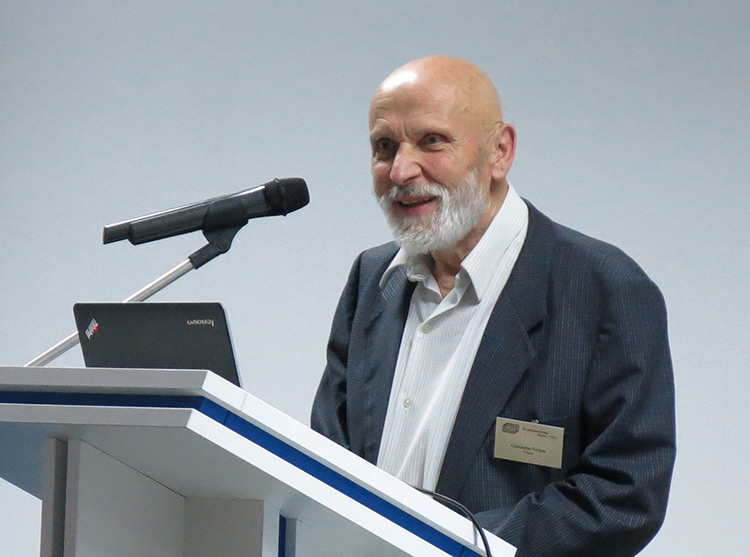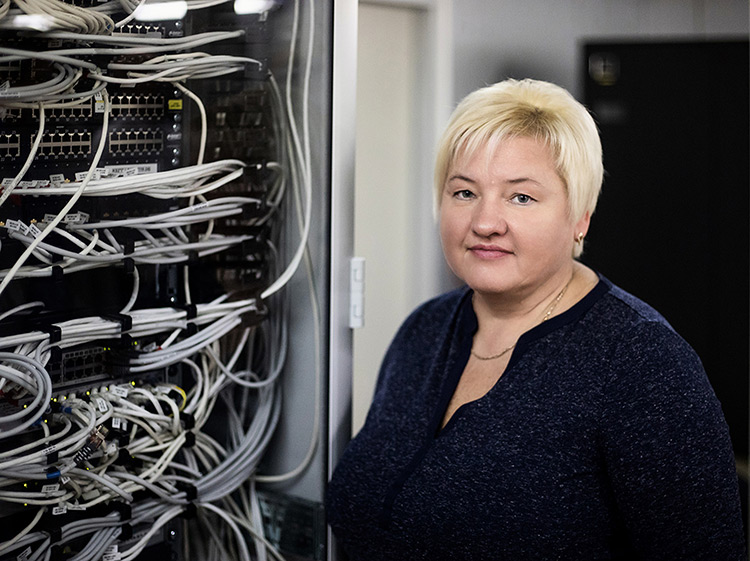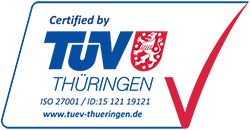Check .lt domain
Why Lithuanian internet users are still lisping?
Even though Internet names, emails and text messages can be written with Lithuanian characters, a large part of Lithuanians do not use the correct spelling online. According to the data of the Internet Service Centre DOMREG at Kaunas University of Technology (KTU), only 2 000 or just 1% of almost 200 000 registered .lt domains are the domain names with specific Lithuanian letters.

We discuss the process of the Lithuanization of the first computers and why Lithuanians avoid the Lithuanian language online with the scientist of the Institute of Data Science and Digital Technologies at Vilnius University, member of the board of the Lithuanian Computer Society dr. Gintautas Grigas.
– You have received the Language Prize for your contribution to the Lithuanization of IT terms, preparation of the dictionary of IT terms, textbooks and publications. Why have you chosen this area of activities?
– I became very interested in these issues when the first computers appeared and the need for the Lithuanian language occurred. In the beginning, I only agitated to use the Lithuanian letter, later I decided to take matters into my own hands. I drew the Lithuanian letters for a keyboard back when the term “font” did not even exist.
The first Lithuanized software was “Demos Mail” email system in “MS DOS” operating system. The texts of this email system were translated into the Lithuanian language; different encodings of the operating systems “MS DOS” and “MS Windows” used in emails at the time were coordinated. The received Lithuanian emails did not need to be transcoded; therefore, there were no excuses for the people to spell incorrectly.
– Could you remind us what were the first computers in Lithuania and how successful was the process of their Lithuanization?
– Speaking of the prehistory of the occurrence of the Lithuanian characters in computers, it should be noted that we had created Pascal translator in 1980 and it had Lithuanian letters. Unfortunately, the first Soviet printers could only print in Russian or English. So, we began a certain “rationalisation” of the printers. we made a Soviet printer to print twice in the same location and put a single quote instead of a tick and a comma instead of an ogonek on the Latin letters.
The first computers were very expensive; it was a luxury to have one. In Lithuania, the use of computers was spreading in schools. The first computer at school was a very primitive Russian BK-1010 with a memory of 64 kB; its operating system required 48 kB, so there was only 16 kB available for programming.
Even though Western computers were also available around 1986, they were almost completely unavailable in the Soviet Union. The number of Western computers began increasing only in 1990 when Lithuania re-established its independence.
The biggest problem at the time was the myths that people believed. Many people thought that computer had only the English alphabet and its entire interface can only be English. The most difficult problem: nobody believed that computer could understand the commands given in Lithuanian. It is similar to the time when the priests told that people needed to pray in Polish because God would not understand Lithuanian.
I remember when we received the French operating system “Windows 3.1” and invited the staff of the Ministry of Education to demonstrate that computer could “talk” other languages besides English. Even though it is strange, at the beginning even the website of our institute was in English. Since it was visible to the entire world, the Lithuanian language was not considered suitable. There were very few websites back then and I used the Estonian website of the University of Tartu as an example of a non-English website.

Gintautas Grigas, Lithuanian Computer Society
– What technical challenges did you face during the Lithuanization of the first computers?
– A huge problem was three different encodings of the specific Lithuanian letters used in “MS DOS” operating system. We used to call it “encoding zoo”; they made it difficult to use Lithuanian letters in emails. Only one standard encoding was appropriate for sending of the Lithuanian emails in the email program “Demos Mail” used at the time. If any other kind of encoding was installed in the sender’s or receiver’s computer, specific Lithuanian letters were converted into different symbols and this problem actuated incorrect spelling. Upon seeing the increasing problem of the incorrect spelling, we started localisation of this email program and arranged it to transcode all the sent emails to one standard “Windows” encoding, and all the received emails to the computer’s encoding.
– Even though right now there are no problems in writing emails and Internet names correctly, many Lithuanians continue to use incorrect spelling online. In your opinion, what are the reasons for this?
– I think the habit of incorrect spelling remains because a standard Lithuanian keyboard is not used often.
In Lithuania, stationary or desktop computers have so-called “numeric” keyboards. These are American keyboards with specific Lithuanian letters in the top row instead of the numbers and other symbols (for example, !, @, #, *). When a person needs to use these symbols, they have to switch to the English keyboard or find other ways to type these symbols.
The student survey of 2018 revealed that students switch between Lithuanian-English-Lithuanian keyboards approximately 15 times per day. It is too much for some people and they start spelling incorrectly.
Another problem - specific Lithuanian letters are not written on many computer keyboards. The sellers explain that computer buyers can write them, use stickers or just memorise. If they are present, the letters are written next to the English keyboard symbols. Writing of the specific letters in the top row of the keyboard where they do not belong, next to other symbols, as if they are auxiliary, makes it seem like these letter are not fully-fledged and therefore, it is not necessary to use them.
The problems arise with app keyboards on the mobile devices – tablets and telephones – that do not have the top row of the numbers with specific Lithuanian letters. Thus, users have no choice but to use incorrect spelling.
– Do other countries also face the problem of incorrect spelling online?
– While learning about the use of the specific letters in other languages, I noticed that foreigners used them normally or at least more often than Lithuanians.
We have analysed the situation by calculating how the people of various nations wrote the titles of their cities with specific letters during their registration in “Skype”. The survey revealed that Danes and Germans write 100% of the titles of their cities correctly, Estonians, Finish and Swedish – approximately 95%, Czechs, Polish, Icelanders - 80%, Spanish – 60%, while Lithuanians – only 18%. In other words, only one Lithuanian in five spells correctly.
While analysing the causes of such huge differences in the use of the specific letters among the nations, we have concluded that it depends on the keyboards. The keyboards of Danes, Germans, Estonians, Finish and Swedish are fully-fledged, i.e., the typing of the specific letters has the same level of convenience as the typing of all the other letters. The keyboards of the other above-mentioned nations are partially fully-fledged.
The fully-fledged standard Lithuanian keyboard (ĄŽERTY) is used by not more than 1% of Lithuanians; the remaining part uses a so-called “numeric” keyboard where all specific letters are more difficult to type because the person needs to switch often. It has been confirmed by another small survey. 81% of the Lithuanians, who admitted to spell incorrectly, stated that specific letters are more difficult to type than other letters.
– Which members of the European Union use the software in their national language most and least of all? How do the largest software developers take into account the national needs?
– First of all, the national language is used by larger countries with larger population. In the European Union, the national language is mostly used by Germany and France, the volume of the translated software is significantly smaller in other countries in proportion to their smaller population.
The members of the European Union that use their national language least of all are Bulgaria, Ireland and Malta. According to the adaptation of the software to the national language, Lithuania is on the same level as Estonia, Latvia and Slovenia that have smaller populations.
The largest software developers have classified languages in the priority groups. For example, the corporation “Microsoft” prioritises the translation of its software to German, French, Italian and Spanish, and later they translate for the smaller markets. The software for the smallest markets, like Lithuania or Latvia, is translated at the latest. However, now translations of the software reach the users faster than before.
Currently, “Windows” operating system and office package “Office” are published in English and Lithuanian at the same time. Smaller software is translated later and less common software is not translated to Lithuanian. Open source software, like “Linux” operating system, is also translated later in comparison to other bigger countries because we have fewer volunteers for its translation.

Daiva Tamulionienė, Head of KTU Internet Service Centre DOMREG
Comment of the Head of KTU Internet Service Centre DOMREG Daiva Tamulionienė regarding the problems of the use of .lt domain names with specific Lithuanian letters:
“In 2003, when ICANN organisation approved the Internationalized Domain Name (IDN) documents for encoding and imaging of the specific national letters in the Internet names, we installed a multi-lingual name system for the registration of .lt domains. We provided a possibility to create the domains with specific Lithuanian letters from 30 March 2004.
Even though, the complex issues of the installation of IDN system were solved, the main issue remained the common habit of writing incorrectly spelled words. Since there were no possibilities to use specific Lithuanian letters for the Internet names, Lithuanians got used to replacing them with the common Latin letters while writing. The habit still remains, even though it is possible to write correctly. Therefore, we face the problems of the incorrectly spelled Internet names, as well as incorrectly spelled emails or text messages (TXT).
The domain names with specific letters of national languages have rapidly gained popularity in other countries (China, Russia, Arabian Peninsula and African countries) and are used widely. It may have been influenced by the writing of these countries that is completely different in comparison to the Latin; therefore, the problem of incorrect spelling is not as relevant as it is in Lithuania.
There is a part of Lithuanians who are not aware of the possibility to use specific Lithuanian letters in domain names; therefore, they only register an incorrectly spelled version of the domain name. Their competitors are quick to take advantage of this situation by registering the same domain name but with specific Lithuanian letters and redirecting the users to a different website.
Therefore, I can give the most important advice: If your domain name has specific Lithuanian letters ą, č, ę, ė, į, š, ų, ū, ž, protect your name by registering both options: with specific Lithuanian letters (for example, gražus-vardas.lt) and with Latin letters (for example, grazus-vardas.lt). Later, you can redirect the users to one of them avoiding the competition for the audience and disputes regarding the misleading similarities between your domain name and another person’s domain caused by a very similar spelling.
Published 2019-03-12



